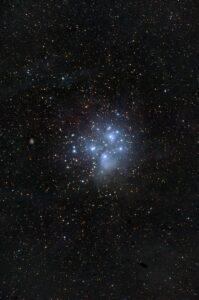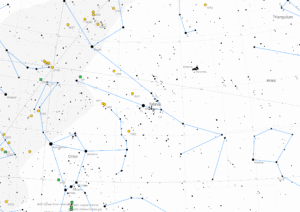An open star cluster in the constellation Taurus
Pleiades
The Pleiades, also known as the Seven Sisters, is a prominent open star cluster located in the constellation Taurus. Easily visible to the naked eye, especially in the Northern Hemisphere during winter, the cluster has been known since antiquity and holds significance in many cultures and mythologies. It consists of several hundred stars, but the brightest and most visible are typically six or seven, depending on viewing conditions and eyesight, hence the traditional name. These stars are relatively young and hot, formed around 100 million years ago, and are surrounded by a faint blue reflection nebula made visible by the dust scattering their light.
Astronomically, the Pleiades are about 444 light-years from Earth and offer valuable insights into stellar formation and evolution. Most of the stars in the cluster are B-type main sequence stars, known for their brightness and blue-white color. The surrounding nebula was once thought to be the remnants of the cluster’s formation, but it is now understood to be an unrelated cloud of interstellar dust that the cluster is currently passing through. The compact and relatively close grouping of the Pleiades allows astronomers to study stellar dynamics and interactions within a young cluster environment.

Culturally, the Pleiades have inspired myths and legends across the globe. In Greek mythology, they are the seven daughters of the titan Atlas and the sea-nymph Pleione, pursued across the sky by the hunter Orion. Many Indigenous cultures also feature the Pleiades prominently in their star lore, often associating the cluster with seasonal changes or agricultural cycles. In Japanese, the cluster is called “Subaru,” which is why the car company Subaru uses a stylized representation of the Pleiades as its logo. This blend of scientific interest and cultural heritage makes the Pleiades one of the most fascinating and enduring star clusters in the night sky.
Nikon D750 at 300 mm on Star Adventurer GTi
Nelson, New Zealand
